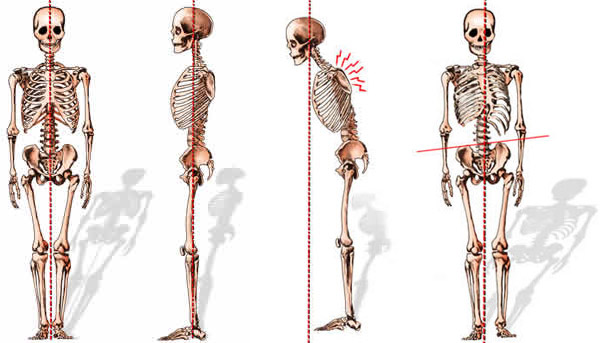
Structural alignment is one of the most fundamental elements of postural health, as well as functional movement. It is absolutely essential for martial arts and self-defense training.
Understanding the structure-balance relationship, and the role it plays in stability and mobility, is a necessity for maintaining your own balance and control, and taking it away from someone else (especially if the other person involved has physical advantages such as size and strength). The following sections will explore this relationship.
Base of Support and Center of Mass
The relationship between these primary aspects of structure dictates whether or not your body is in or out of a state of balance. Balance is not a mysterious quality that some posses and others don’t, it is a state achieved when the center of mass is aligned over the center of the base of support.
The base of support is defined as a sort of imaginary box drawn by making a line from the tips of one set of toes to the others and from one heel to the other. The center of this base of support is your optimal balance point. Your center of mass in an upright or vertical posture, is defined as the core mass of the body along its vertical and horizontal axes, usually located below the navel and midway between the hips and the belly and spine. When the center of mass is over the center of your base, you are in a state of balance. If you shift your center over the center of one foot, that foot now supports all your mass (weight) and the other foot becomes a passive support structure, meaning it is free to move without affecting your balance.
Alignment and Multiple Centers of Mass
Although the pelvic center of mass is generally referred to as the center, the truth is a bit more complex, but important for understanding balance. For the sake of keeping things as simple as possible, let’s say that the head and torso comprise four centers of mass: the head, chest, abdominal, and pelvic centers. When these centers all line up over the center of your base of support, you’re in balance. However, to the extent they shift out of alignment with the center of your base, your balance becomes more precarious and difficult to maintain. The weight of your masses will pull on your vertical axis (an imaginary vertical line extending up from the center of your base of support) which will cause excessive muscular tension to support your posture at the least. If your true center of mass moves beyond the edge of your base of support, you start to fall.
True Center and Counter-Balancing
The reason the pelvic center is often referred to as the center is because it is the last stop for the weight of all the masses above it before encountering your support structures (which are your legs when standing). However, your true center can shift and change according to your posture. For example, if you stand upright and begin to lean your head and chest forward, there will come a point in which your pelvis begins to shift back. It may happen so fast and subtly that you don’t even notice it at first. If you look in the mirror at yourself from the side, you’ll find that you’re sticking out your rear end. Your true center of mass has become your abdominal center. It may be possible for some people to even be able to stick out their rear far enough (and counter-balance with their arms likely) to shift their true center to their chest (or thoracic) center of mass. The same experiment can be done by seeing how far back you can lean. Extending the limbs can also increase the amount of mass on one side of the center of your base and shift your true center. If you’re not falling, you’ve stayed in balance. If you want to see truly impressive examples of shifting true center through counter balancing, check out a Cirque du Soleil performance.
Strong Line and Weak Line
Your base of support has a strong line and a weak line. Often the strong line is referred to as the base-line. In any posture, it is the longest line running through the center of your base of support. I refer to it as the strong line because it is the line along which your base of support can absorb the most force. The weak line runs between your support structures (your feet and legs when standing). In any posture it is the line through the center of your base along which you can absorb the least force. It also tends to be the shortest line to move the center of mass beyond the base of support. By continuing along the weak line to a distance from your center of base equivalent to the height of your true center of mass, you find the triangulation points.
Triangulation Points, Tumble Point and Fall Points
There are two triangulation points to any stance (or any two support structure base). If you stand with your feet parallel and somewhat apart (shoulder width is a good starting point) then imagine the center of each foot represents a corner in a triangle on the floor, you’ll see that the third corner could be in front of you, or behind you. You can experiment with different arrangements of your feet (different stances) and practice finding the triangle points. Once you’ve located it, shift your true center of mass (if upright it’s your pelvic center) toward one of the two points. You’ll quickly feel a loss in balance. If you don’t shift back over your base of support, or take a step (creating a new base of support under your center of mass) you will fall. While the triangle points are the shortest path to move the center of mass off of the base of support (and put someone on the ground) there are essentially infinite fall points. A fall point is any point outside of the base of support where the center of mass will reach the ground. All you have to do is shift a person’s center of mass outside the edge of their base of support and prevent them from counter balancing or stepping to replace their base. It’s worth noting that the triangulation points are just the two nearest and structurally most vulnerable fall points. Tumble point is the point at which the center of mass is just about to drop off the edge of the base of support and descend toward a fall point.
Lengthening and Shortening the Base-line and the Optimal Base of Support.
The stability of our structure is based upon the relationship between the width and depth of our base of support and the height of our center of mass. If our base is narrow, such as having the feet together or being on one foot, and our center of mass is high up, such as having your leg or legs fully extended, the inverse ratio of height of mass to width of support becomes very unstable. Think of trying to set a pen down on its end. The slightest breath would knock it over. As we widen our base and lower our center of mass, that ratio improves, eventually reaching an optimal state of stability without sacrificing mobility. As your feet continue to lengthen apart and your center of mass gets lower to the ground, you move beyond your optimal base of support and your stability and balance become increasingly precarious. Remember that your triangle points are found by considering the distance of your center of mass (true center) from the ground and the length of your base-line. The lower your center of mass and longer your base-line, the nearer your triangulation points come to the edge of your base of support. Imagine setting a cellphone on its long edge. The lightest touch would knock it down. While in your optimal base of support, you combine stability and mobility, because your feet are close enough to your center of mass (as a point on the ground) that you can shift your center over a single foot and move the other one quickly and easily. Also, your legs and feet are aligned more below your mass, which roots them to the ground and provides more contact friction between your feet and the ground.
Active and Passive Support Structures and Sweeping the Base
Earlier I mentioned that shifting your center of mass over one foot frees the other foot to move without disrupting your balance. This same notion can be used to make a leg heavier or lighter. When attempting a sweep (removing the base of support out from under the center of mass) you’ll find that it is very difficult to move the leg supporting the majority of the weight. The weight roots the foot to the ground and the friction it creates makes the leg very stable. However, if you move the center of mass over the other foot, you will make the foot you’re trying to sweep lighter, decreasing its friction against the ground and making it relatively easy to move. This is sometimes referred to as bumping the base-line. This takes some subtlety. If you bump too far toward the other foot, you will empty the foot you’re trying to sweep (no mass weighing it down – passive support structure) and this will free it to make a corrective step and escape your sweep. If you bump even further along the base-line, their center of mass will go outside their base of support and they will stumble away from you. When you bump the base-line, make sure the target leg remains an active support structure (center of mass remains dependent on its support for balance). When you move the foot, move it away from the current base-line without allowing the center of mass to move with it – in this way, the center of their base of support becomes a triangulation point beneath them and they fall straight down. You may also find that moving the target leg of your sweep along a diagonal path on the floor relative to their base-line is harder for the person to adjust and recover from. Human perception and human movement is not accustomed to dealing with diagonals.
